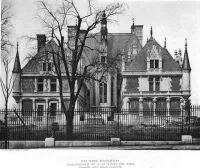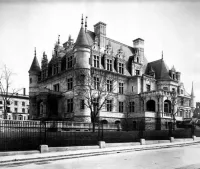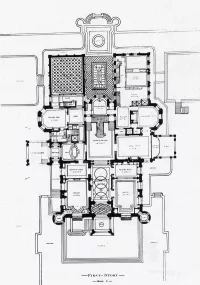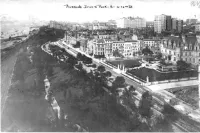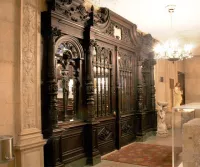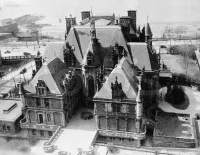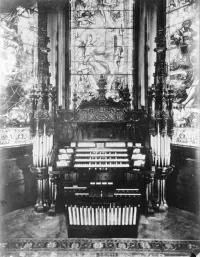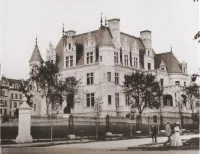Share what you know,
and discover more.
Share what you know,
and discover more.
Oct 26, 2011
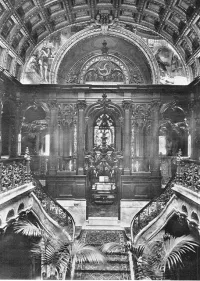
-

- Marley Zielike
The Charles M Schwab Mansion
Charles M Schwab was an American steel magnate. He worked under Andrew Carnegie and soon surpassed his former employer in his choice for housing. Schwab decided he would build the largest, most grand mansion on the "wrong" side of Central Park. He purchased a city block and began construction on his 75 room mansion and was completed in 1901. The style of the home was beaux-arts with French Renaissance style more in line of a church than a formal house. With an estimated cost of 6 million to complete Andrew Carnegie once remarked "Have you seen that place of Charlie's? It makes mine look like a shack." Riverside house as it came to be known was set upon park like land. The home contained all the finest items money could buy. There was a large chapel, in the basement was a 20 x 30 ft pool, had 6 elevators and had its own power plant with central air conditioning. Sadly the grand house would fall like so many others. The great depression hit hard and wiped out all Schwab's money. Schwab had to move into a small apartment on Park Ave where he died penniless in 1939. The land was bought by a developer and after a sale of the interior fittings the home was knocked down.
The Charles M Schwab Mansion
Charles M Schwab was an American steel magnate. He worked under Andrew Carnegie and soon surpassed his former employer in his choice for housing. Schwab decided he would build the largest, most grand mansion on the "wrong" side of Central Park. He purchased a city block and began construction on his 75 room mansion and was completed in 1901. The style of the home was beaux-arts with French Renaissance style more in line of a church than a formal house. With an estimated cost of 6 million to complete Andrew Carnegie once remarked "Have you seen that place of Charlie's? It makes mine look like a shack." Riverside house as it came to be known was set upon park like land. The home contained all the finest items money could buy. There was a large chapel, in the basement was a 20 x 30 ft pool, had 6 elevators and had its own power plant with central air conditioning. Sadly the grand house would fall like so many others. The great depression hit hard and wiped out all Schwab's money. Schwab had to move into a small apartment on Park Ave where he died penniless in 1939. The land was bought by a developer and after a sale of the interior fittings the home was knocked down.
Oct 26, 2011
The Charles M Schwab Mansion
Charles M Schwab was an American steel magnate. He worked under Andrew Carnegie and soon surpassed his former employer in his choice for housing. Schwab decided he would build the largest, most grand mansion on the "wrong" side of Central Park. He purchased a city block and began construction on his 75 room mansion and was completed in 1901. The style of the home was beaux-arts with French Renaissance style more in line of a church than a formal house. With an estimated cost of 6 million to complete Andrew Carnegie once remarked "Have you seen that place of Charlie's? It makes mine look like a shack."Riverside house as it came to be known was set upon park like land. The home contained all the finest items money could buy. There was a large chapel, in the basement was a 20 x 30 ft pool, had 6 elevators and had its own power plant with central air conditioning. Sadly the grand house would fall like so many others. The great depression hit hard and wiped out all Schwab's money. Schwab had to move into a small apartment on Park Ave where he died penniless in 1939. The land was bought by a developer and after a sale of the interior fittings the home was knocked down.
Posted Date
Aug 04, 2023
Historical Record Date
Oct 26, 2011
Source Name
1889 VICTORIAN HOUSE RESTORATION
Delete Story
Are you sure you want to delete this story?
Jun 01, 1915
Jun 01, 1915
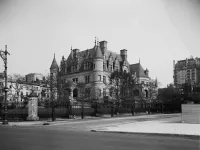
-

- Marley Zielike
11 Riverside Drive, New York, NY 10023, USA
The Charles M. Schwab House (also called Riverside) was a 75-room mansion on Riverside Drive, between 73rd and 74th Streets, on the Upper West Side of Manhattan in New York City. It was constructed for steel magnate Charles M. Schwab. The home was considered to be the classic example of a "white elephant", as it was built on the "wrong" side of Central Park away from the more fashionable Upper East Side. The home was designed by an architect with only a modest reputation, Maurice Hébert, as an eclectic Beaux-Arts mixture of pink granite features that made the Vanderbilt mansions on Fifth Avenue look cramped. It combined details from three French Renaissance châteaux: Chenonceau, the exterior staircase from Blois, and Azay-le-Rideau. It took four years to build the home (1902–1906) at a cost of six million dollars. Schwab's former employer Andrew Carnegie, whose own mansion on upper Fifth Avenue later became the Cooper-Hewitt Museum, once remarked, "Have you seen that place of Charlie's? It makes mine look like a shack."[citation needed] Schwab was a self-made man who became president of U.S. Steel and later founded Bethlehem Steel Company. Schwab built "Riverside" after leaving Bethlehem, Pennsylvania for New York. The large property was available because it formed half the site of the former New York Orphan Asylum, one of several charitable institutions in the Bloomingdale District that gave way to large projects in Morningside Heights, such as the Cathedral of St. John the Divine and Columbia University's campus. The Ansonia Hotel now occupies the orphans' Broadway frontage. The financier Jacob Schiff had bought the parcel, but—ominously for the social future of the Upper West Side—Mrs. Schiff refused to move to the "wrong" side of Central Park. Schwab was a risk-taker and later went bankrupt in the Wall Street Crash of 1929. He died comparatively penniless ten years later in 1939, bequeathing the forlorn "Riverside" to the City as a suitably ostentatious official residence for the mayors of New York. It is probable that former mayor Jimmie Walker would have moved into the residence, but, unfortunately for the mansion, Fiorello La Guardia, then the mayor, was reform-minded and turned it down, saying "What, me in that?" Schwab House apartment building, 74th Street La Guardia's rejection of the mansion sealed its fate, and during World War II, a Victory garden was planted in its once-landscaped grounds. Eventually, the many dwellings around the home became overcrowded and Riverside Drive lost whatever affluence and wealth that had existed. By 1947 the house was empty and in 1948 it was replaced by a large, red-brick apartment complex, called the "Schwab House."
11 Riverside Drive, New York, NY 10023, USA
The Charles M. Schwab House (also called Riverside) was a 75-room mansion on Riverside Drive, between 73rd and 74th Streets, on the Upper West Side of Manhattan in New York City. It was constructed for steel magnate Charles M. Schwab. The home was considered to be the classic example of a "white elephant", as it was built on the "wrong" side of Central Park away from the more fashionable Upper East Side. The home was designed by an architect with only a modest reputation, Maurice Hébert, as an eclectic Beaux-Arts mixture of pink granite features that made the Vanderbilt mansions on Fifth Avenue look cramped. It combined details from three French Renaissance châteaux: Chenonceau, the exterior staircase from Blois, and Azay-le-Rideau. It took four years to build the home (1902–1906) at a cost of six million dollars. Schwab's former employer Andrew Carnegie, whose own mansion on upper Fifth Avenue later became the Cooper-Hewitt Museum, once remarked, "Have you seen that place of Charlie's? It makes mine look like a shack."[citation needed] Schwab was a self-made man who became president of U.S. Steel and later founded Bethlehem Steel Company. Schwab built "Riverside" after leaving Bethlehem, Pennsylvania for New York. The large property was available because it formed half the site of the former New York Orphan Asylum, one of several charitable institutions in the Bloomingdale District that gave way to large projects in Morningside Heights, such as the Cathedral of St. John the Divine and Columbia University's campus. The Ansonia Hotel now occupies the orphans' Broadway frontage. The financier Jacob Schiff had bought the parcel, but—ominously for the social future of the Upper West Side—Mrs. Schiff refused to move to the "wrong" side of Central Park. Schwab was a risk-taker and later went bankrupt in the Wall Street Crash of 1929. He died comparatively penniless ten years later in 1939, bequeathing the forlorn "Riverside" to the City as a suitably ostentatious official residence for the mayors of New York. It is probable that former mayor Jimmie Walker would have moved into the residence, but, unfortunately for the mansion, Fiorello La Guardia, then the mayor, was reform-minded and turned it down, saying "What, me in that?" Schwab House apartment building, 74th Street La Guardia's rejection of the mansion sealed its fate, and during World War II, a Victory garden was planted in its once-landscaped grounds. Eventually, the many dwellings around the home became overcrowded and Riverside Drive lost whatever affluence and wealth that had existed. By 1947 the house was empty and in 1948 it was replaced by a large, red-brick apartment complex, called the "Schwab House."
11 Riverside Drive, New York, NY 10023, USA
The Charles M. Schwab House (also called Riverside) was a 75-room mansion on Riverside Drive, between 73rd and 74th Streets, on the Upper West Side of Manhattan in New York City. It was constructed for steel magnate Charles M. Schwab. The home was considered to be the classic example of a "white elephant", as it was built on the "wrong" side of Central Park away from the more fashionable Upper East Side.The home was designed by an architect with only a modest reputation, Maurice Hébert, as an eclectic Beaux-Arts mixture of pink granite features that made the Vanderbilt mansions on Fifth Avenue look cramped. It combined details from three French Renaissance châteaux: Chenonceau, the exterior staircase from Blois, and Azay-le-Rideau. It took four years to build the home (1902–1906) at a cost of six million dollars.
Schwab's former employer Andrew Carnegie, whose own mansion on upper Fifth Avenue later became the Cooper-Hewitt Museum, once remarked, "Have you seen that place of Charlie's? It makes mine look like a shack."[citation needed]
Schwab was a self-made man who became president of U.S. Steel and later founded Bethlehem Steel Company. Schwab built "Riverside" after leaving Bethlehem, Pennsylvania for New York. The large property was available because it formed half the site of the former New York Orphan Asylum, one of several charitable institutions in the Bloomingdale District that gave way to large projects in Morningside Heights, such as the Cathedral of St. John the Divine and Columbia University's campus. The Ansonia Hotel now occupies the orphans' Broadway frontage. The financier Jacob Schiff had bought the parcel, but—ominously for the social future of the Upper West Side—Mrs. Schiff refused to move to the "wrong" side of Central Park.
Schwab was a risk-taker and later went bankrupt in the Wall Street Crash of 1929. He died comparatively penniless ten years later in 1939, bequeathing the forlorn "Riverside" to the City as a suitably ostentatious official residence for the mayors of New York. It is probable that former mayor Jimmie Walker would have moved into the residence, but, unfortunately for the mansion, Fiorello La Guardia, then the mayor, was reform-minded and turned it down, saying "What, me in that?"
Schwab House apartment building, 74th Street
La Guardia's rejection of the mansion sealed its fate, and during World War II, a Victory garden was planted in its once-landscaped grounds. Eventually, the many dwellings around the home became overcrowded and Riverside Drive lost whatever affluence and wealth that had existed. By 1947 the house was empty and in 1948 it was replaced by a large, red-brick apartment complex, called the "Schwab House."
Posted Date
Aug 04, 2023
Historical Record Date
Jun 01, 1915
Source Name
Wikipedia
Delete Story
Are you sure you want to delete this story?


